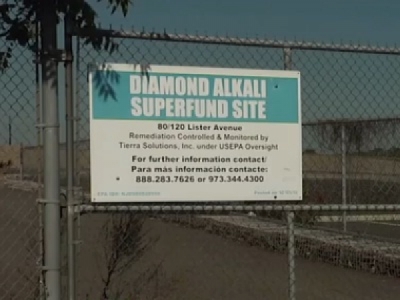
Posted on October 11, 2016
By Erin Delmore, NJTVNews
“New Jersey’s biggest crime scene.” That’s how U.S. Sen. Cory Booker once described the area around the old Diamond Alkali manufacturing plant, a Superfund site along the Passaic River.
“I’ve been battling for this since I was mayor. The polluted, toxic river that was stolen from people in Newark, stolen from people along the Passaic because companies just dumped stuff in,” Booker said.
The area is now one step closer to cleanup. The EPA secured a $165 million settlement with Occidental Chemical to cover a design project ahead of construction. The agency says that cost alone is more than it takes to clean up many Superfund sites.
“This will be the largest environmental dredging project in the history of the federal Superfund program,” said Walter Mugdan, EPA director of the Region 2 Superfund Division.
The plan is to cap and dredge the the lower 8.3 miles of the Passaic River from the Newark/Belleville boarder to Newark Bay. The EPA says that stretch is home to 90 percent of the total contamination. Including, 13 pounds of dioxin, a byproduct of Agent Orange produced during the Vietnam War. Plus, 24,000 pounds of mercury, almost 7,000 pounds of PCBs and more than 1,000 pounds of DDT. The plan is to dredge those toxins from the river bank then cap the floor to prevent contamination.
The EPA’s plan is to dredge 3.5 million cubic yards of contaminated sediment from the lower 8.3 miles of the Passaic River. Now, one cubic yard is the size of a dishwasher. 3.5 million of them? The EPA says, that’s enough to fill Red Bull Arena three times over.
“The dredged material, which is contaminated, will then be brought to a facility that has to be designed and built and that facility will de-water, it’ll squeeze the water out of the mud. The dried mud will then be transported almost certainly by train to a licensed disposal facility the water that gets squeezed out will be treated, probably to drinking water standards, and will be returned back into the river,” Mugdan said.
Activists say Newark is headed for one of the most massive construction projects in recent history and they say it’s long overdue.
“I grew up a block from this river and we grew up fearing the river and really not seeing it as a resource or an ecosystem but seeing it as a source of contamination and pollution and something to stay away from and fear,” said Passaic River Community Advisory Group Co-Chair Ana Baptista.
“Folks are fighting to get access, to keep it, to clean up the river. We want to see those same people able to enjoy the river in years to come,” said Ironbound Community Corporation Environmental Justice Organizer Melissa Miles.
Under the federal Superfund law, the polluter pays, not the taxpayers. The EPA says this settlement is the first step toward collecting more funds from more responsible parties. Design, engineering and construction costs are expected to run upwards of $1.3 billion.
“I want to praise the EPA for staying on this issue and the fact that we now are going to start seeing some significant things being done to clean up the Passaic River and return it to public use from fishing to boating to all of those things I see in the future being possible,” Booker said.
“There’s a vision here, for the waterfront of Newark. It includes a great water front park. The third phase of that was just a groundbreaking yesterday and so we are going to return this river back to the community so that they can use it,” said Debbie Mans, Execuative Director of NY/NJ Baykeeper.
Occidental Chemical told NJTV News in a statement “We are pleased to have reached an agreement” and “looks forward to partnering with the agency”.
“Four years of design, six years of construction, we’re talking about a 10-year project, sounds like a long time, but it’s important to remember that the contamination took about 150 or 200 years to be created, and so to spend a decade to clean it up, is understandable when you’re talking about this kind of scale of a project,” Mugdan said.
The EPA says there are another 100 or so companies liable for the damage, and another nine miles of the river that need to be cleaned up. The agency’s representative told us, “We’re not going anywhere.”
Source: NJTVNEWS





